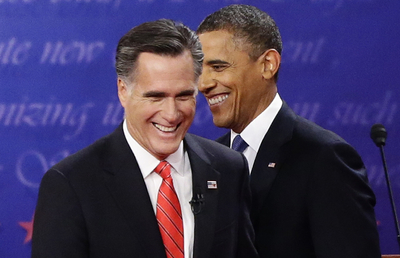
President Barack Obama and Republican presidential candidate and former Massachusetts Gov. Mitt Romney talk at the end of the first presidential debate in Denver, October 3, 2012. (photo credit: AP/Charles Dharapak) |
Republican hopeful Governor Mitt Romney laid out his vision for American foreign policy in his October 2012 address entitled, “The Mantle of Leadership,” and it demonstrated a different understanding of the U.S. role in international affairs than the approach followed by President Barack Obama. Aside from a definitive change in tone from previous years, there are specific and substantive differences in how both candidates would handle Iran.
Drawing his own red line, Romney said the United States and its allies “will prevent [Iran] from acquiring nuclear weapons capability.” The key word here is capability, whereas President Obama’s stated red line is that Iran cannot have a nuclear weapon. The difference is significant because Obama’s policy would presumably allow Iran to enrich and stockpile weapons-grade uranium (WGU). Iran would then be able to carry out the final step necessary to make a nuclear weapon secretly and quickly. That means President Obama’s current policy is unenforceable, which is no doubt why Israeli Prime Minister Benjamin Netanyahu devoted much of his speech before the United Nations in September to drawing out a distinction in red lines.
All of this should be seen in a context where the United States used to accept zero percent enrichment from Iran and previously worked to pass six United Nations Security Council resolutions calling for Iran to give up its nuclear program in its entirety. Those resolutions have gone unenforced, and earlier this year, the administration appeared to acquiesce to 3-5 percent enrichment. Lately, it’s been hard to tell whether 20 percent enrichment and higher is palatable to the White House.
Mitt Romney’s formulation — preventing Iran from acquiring the capability to produce a weapon — appears to more closely match Netanyahu’s red line. That red line was reinforced during the Vice Presidential debate where Paul Ryan stressed capability over Joe Biden’s weaponization. Further bolstering the idea that a Romney administration would closely coordinate with Israel, he followed the section on Iran in his speech by pledging to “reaffirm our historic ties with Israel and our abiding commitment to its security — the world must never see daylight between our two nations.”
Putting Iran on notice while standing with Israel marks a difference in public messaging over the current administration. Following reports in the media would lead one to believe that current U.S. and Israeli objectives vis-à-vis Iran are different, as the bulk of U.S. messaging is devoted to preventing Israel from attacking Iran’s nuclear facilities, rather than preventing Iran from gaining a nuclear weapons capability.
Mixed Messages from Washington
In contrast to Mitt Romney’s clarity, the Obama administration has sent contradictory messages to Iran that serve to undermine its ongoing diplomatic efforts. While President Obama has said that Iran will not be allowed to have nuclear weapons, Secretary of State Hillary Clinton stated that US policy “is to prevent Iran from having nuclear weapons capability.” Contradicting the U.S. emphasis on capability was Defense Secretary Leon Panetta who in December 2011 suggested that Iran could build a bomb within a year if it chose to do so. National Intelligence Director James Clapper also weighed in earlier this year, telling the Senate that “Iran has the scientific, technical, and industrial capacity to eventually produce nuclear weapons, making the central issue its political will to do so.”
Adding to the administration’s messaging mess are the frequent comments made by senior U.S. officials stressing that there is no clear evidence that Iran has decided to make a nuclear weapon. How, then, does the current administration measure nuclear capability? If the administration believes that Iran has not yet decided to build a nuclear weapon, is Iran’s nuclear program even seen as a problem?
President Obama’s formulation, where “all options are on the table,” or Leon Panetta’s formulation that if Iran develops a nuclear weapon, Washington would “take whatever steps necessary to stop it,” are not credible when both Panetta and Joint Chiefs Chairman General Martin Dempsy publicly state how problematic a U.S. attack on Iran would be, let alone an Israeli attack. The U.S. military deterrent is further compromised when Panetta emphasizes that a military attack would be “really destabilizing” and “of greater concern to me are the unintended consequences.”
America’s Credibility Gap
Each red line offered by this administration has been pink, and the Iranian regime has not suffered the kind of repercussions that would force it to modify its behavior. The visible space Mr. Obama has placed between the U.S. and Israel on this crucial issue has undermined Israeli trust in this administration. Taken together, it has created a credibility problem for Obama among friend and foe alike.
For his part, Mitt Romney stopped short of threatening overt military action against Iran. That is likely a wise decision to avoid being labeled a warmonger during the election campaign.
The truth, however, is that setting a red line is a tool of diplomacy that can create stability and avoid possible conflicts. It provides the context for negotiations. Yet Barack Obama’s insistence that “time is not unlimited” while publicly pleading for Israel’s patience is a far cry from a red line. From Iran’s perspective, the threat of military force is not credible when Mr. Obama’s red lines are not fixed and his administration disparages the possible effectiveness of a military strike, all the while belittling Israel’s security concerns by likening its unease to “noise.”
Romney pointed to America’s perceived weakness by the rulers of Tehran, saying that Iran “has never acted less deterred by America, as was made clear last year when Iranian agents plotted to assassinate the Saudi Ambassador in our nation’s capital.” Recognizing that all options do not currently appear to be on the table, Romney pledged to “restore the permanent presence of aircraft carrier task forces in both the Eastern Mediterranean and the Gulf region — and work with Israel to increase our military assistance and coordination.” Undoubtedly, America’s weakness abroad and the White House’s lack of a clear Middle East policy is what the governor was referring to when he said “America must have confidence in our cause, clarity in our purpose, and resolve in our might.”
Can Economic Sanctions Work?
Absent a credible military threat and without enforceable red lines, economic sanctions have become the centerpiece of the Obama administration’s deterrent strategy. President Obama is fond of proclaiming that his administration passed “the toughest sanctions ever imposed on the Iranian government.” But while they are extensive, they also remain under-enforced, and are only crippling the Iranian people — not the regime. Given Tehran’s crushing response to the thousands that gathered in 2009 to protest the fraudulent presidential elections, it is clear that the well-being of the Iranian people is far less a consideration than maintaining the stability of the regime. And the regime’s stability is greatly enhanced and insulated from foreign threats if it possesses nuclear weapons.
Mitt Romney, for his part, explained that he “will not hesitate to impose new sanctions on Iran, and will tighten the sanctions we currently have.” This is an important distinction because the full arsenal of U.S. economic sanctions has yet to be brought to bear against the threat from Iran. China, Singapore, Japan, and 10 European countries including France, Germany, Italy, and Belgium, have been extended waivers on the sanctions. Meanwhile, the Obama administration has been reluctant to enforce the sanctions against foreign companies that do business with Iran, despite the wide and bipartisan room Congress has granted the president to maneuver.
The structural problem in America’s current Iran policy persists in that the Obama administration often confuses tactics for strategy. Sanctions are a tactic; they are not a strategy in and of themselves. For sanctions to be effective in modifying the behavior of the Iranian regime, they have to be combined with other tactics such as military, messaging, and ideological components. Moreover, most evidence suggests that sanctions grow less effective over time. The only way they could succeed is if the people in Iran rise up to depose the regime. And that will require a different approach from the policy President Obama promulgated in 2009, when he stood by as the Iranian regime brutally crushed the opposition. Unfortunately at the time, Iran’s pro-reform Green Movement was seen as an obstacle to the White House’s diplomatic engagement tactic with the regime.
A Different Approach
Perhaps the most hopeful aspect of Mitt Romney’s speech on foreign policy in the Middle East was his recognition that “[t]he greater tragedy of it all is that we are missing an historic opportunity to win new friends who share our values in the Middle East — friends who are fighting for their own futures against the very same violent extremists, and evil tyrants, and angry mobs who seek to harm us.”
In contrast to the current U.S. policy toward Iran, Mitt Romney demonstrated an understanding that the U.S. should stand with the people of Iran against the Islamic regime; that a comprehensive strategy must be employed against Iran’s rulers; that solid red lines must be drawn with American allies and enforced; and that America’s military threat must be credible. In all, it was a recognition that preventing Iran from getting a nuclear weapon can only happen with stronger and more effective American leadership abroad.





